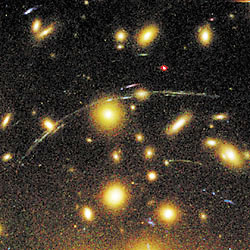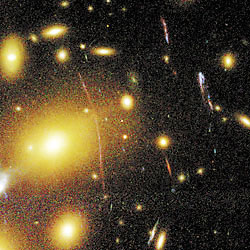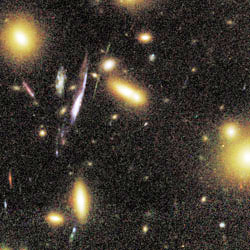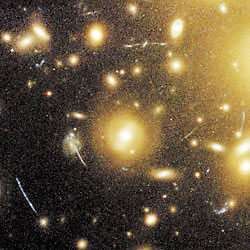
A tiny part of Hubble's new image of the galaxy cluster Abell 1689 in Virgo. Note the many thin arcs — gravitationally distorted images of galaxies far in the background. The image was taken in a combination of visible and near-infrared light. The entire full-resolution version (3.6 MB), covering about 30 times the area of this detail, is available along with a Hubble press release.
Courtesy NASA, N. Benitez et al., the ACS Science Team, and ESA.
The Hubble Space Telescope's new super-instrument, the Advanced Camera for Surveys (ACS), is at it again. Released on Tuesday is an image nothing short of breathtaking — the best-ever view of a distant, massive galaxy cluster and what lies behind it.
With ACS as its eye, Hubble peered through the galaxy cluster Abell 1689 some 2.2 billion light-years away to a funhouse-mirror scene of incredible structure and dynamics. The gravity of the cluster's trillion stars, in concert with an even greater amount of dark matter, turns the cluster into a huge gravitational lens 2 million light-years wide. The cluster's gravitational field bends the light from distant background galaxies, distorting and often enlarging their images almost the way a magnifying lens enlarges an object beneath it.

A small part of Hubble's new image of the galaxy cluster Abell 1689 in Virgo. Note the many thin arcs — gravitationally distorted and magnified images of galaxies far in the background. The image was taken in a combination of visible and near-infrared light. The entire full-resolution version (3.6 MB), covering about 30 times the area of this detail, is available along with a Hubble press release.
Courtesy NASA, N. Benitez et al., the ACS Science Team, and ESA.
Many of the background galaxies in the image are too far and faint to be seen any other way. Galaxies as distant as 13 billion light-years (redshift value 6) appear distorted into arcs and curves. In a few cases a galaxy can appear warped into a complete ring. Of particular note are the details seen within the arcs. Close inspection reveals structure — some of the curves are identifiable as spiral and elliptical galaxies. Many others are small, patchy, pre-galaxy fragments of the sort that that populated the early universe in great numbers.

A small part of Hubble's new image of the galaxy cluster Abell 1689 in Virgo. Note the many thin arcs — gravitationally distorted and magnified images of galaxies far in the background. The image was taken in a combination of visible and near-infrared light. The entire full-resolution version (3.6 MB), covering about 30 times the area of this detail, is available along with a Hubble press release.
Courtesy NASA, N. Benitez et al., the ACS Science Team, and ESA.
"It’s really amazing," says ACS team member Narciso Benitez (Johns Hopkins University). This level of detail "would be impossible to see from the ground."
The image is a testament to the power of ACS. The camera’s sensitivity allows it to view 10 times more arcs in Abell 1689 than in any ground-based image and five times more than were seen by Hubble’s previous super-camera, the Wide Field and Planetary Camera 2.

A small part of Hubble's new image of the galaxy cluster Abell 1689 in Virgo. Note the many thin arcs — gravitationally distorted and magnified images of galaxies far in the background. The image was taken in a combination of visible and near-infrared light. The entire full-resolution version (3.6 MB), covering about 30 times the area of this detail, is available along with a Hubble press release.
Courtesy NASA, N. Benitez et al., the ACS Science Team, and ESA.
Gravitational lensing is well known, but never have astronomers seen it quite so dramatically. Thousands of arcs and arclets can be detected in the full-resolution version (3.6 MB), each providing clues to the matter distribution and curvature of space within the massive cluster.
The magnifying effect of the lens makes this the "deepest look at the high-redshift universe taken so far," says Benitez. "It is a couple of magnitudes deeper than the Hubble Deep Field [the previous record holder]. It is probably telling us something about the evolution of the universe."
Astronomers are already identifying some curious trends. For example, about 30 galaxies here seem to have redshifts greater than 5, meaning we see them as they were when the universe was less than 9 percent of its present age, or less than 1.1 billion years after the Big Bang. But only three are candidates for having a redshift around 6 (cosmic age 900 million years). "Why is there such a huge drop in galaxy numbers at z = 6?" asks Benitez. For now, the answer remains elusive.
 0
0
Comments
You must be logged in to post a comment.